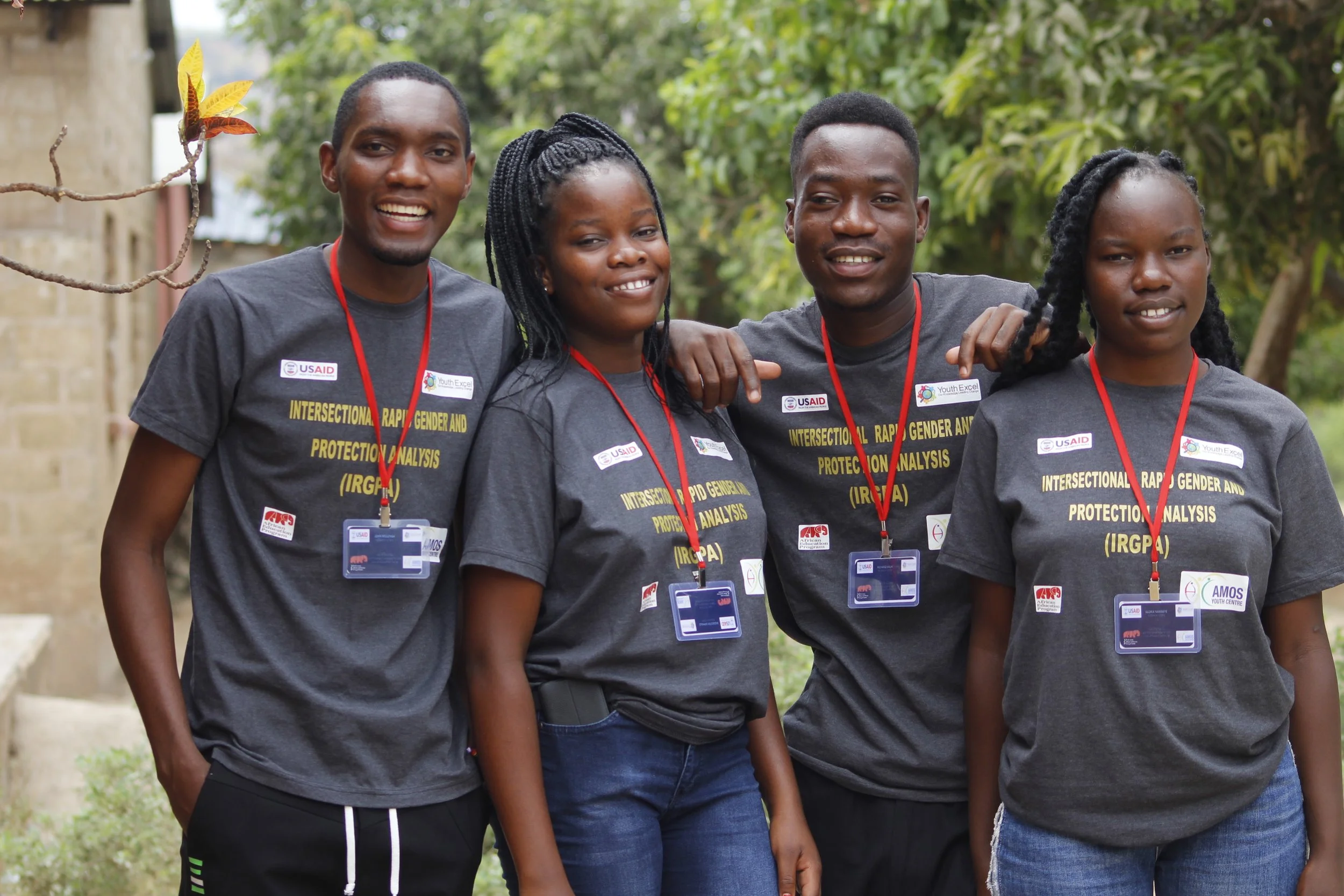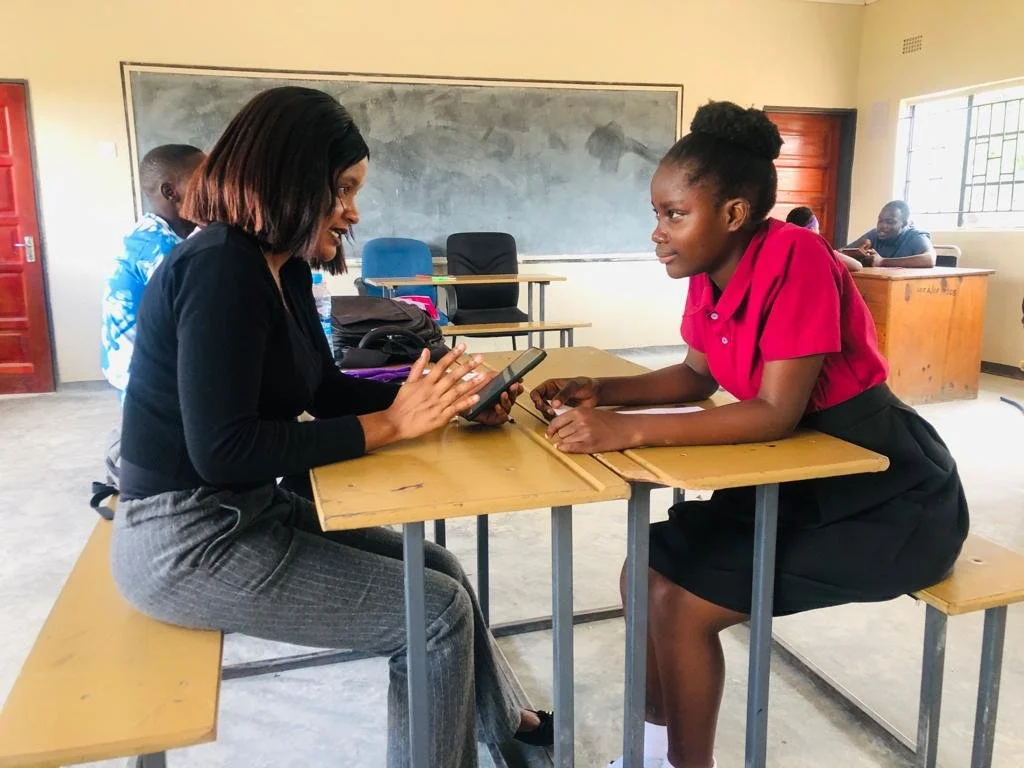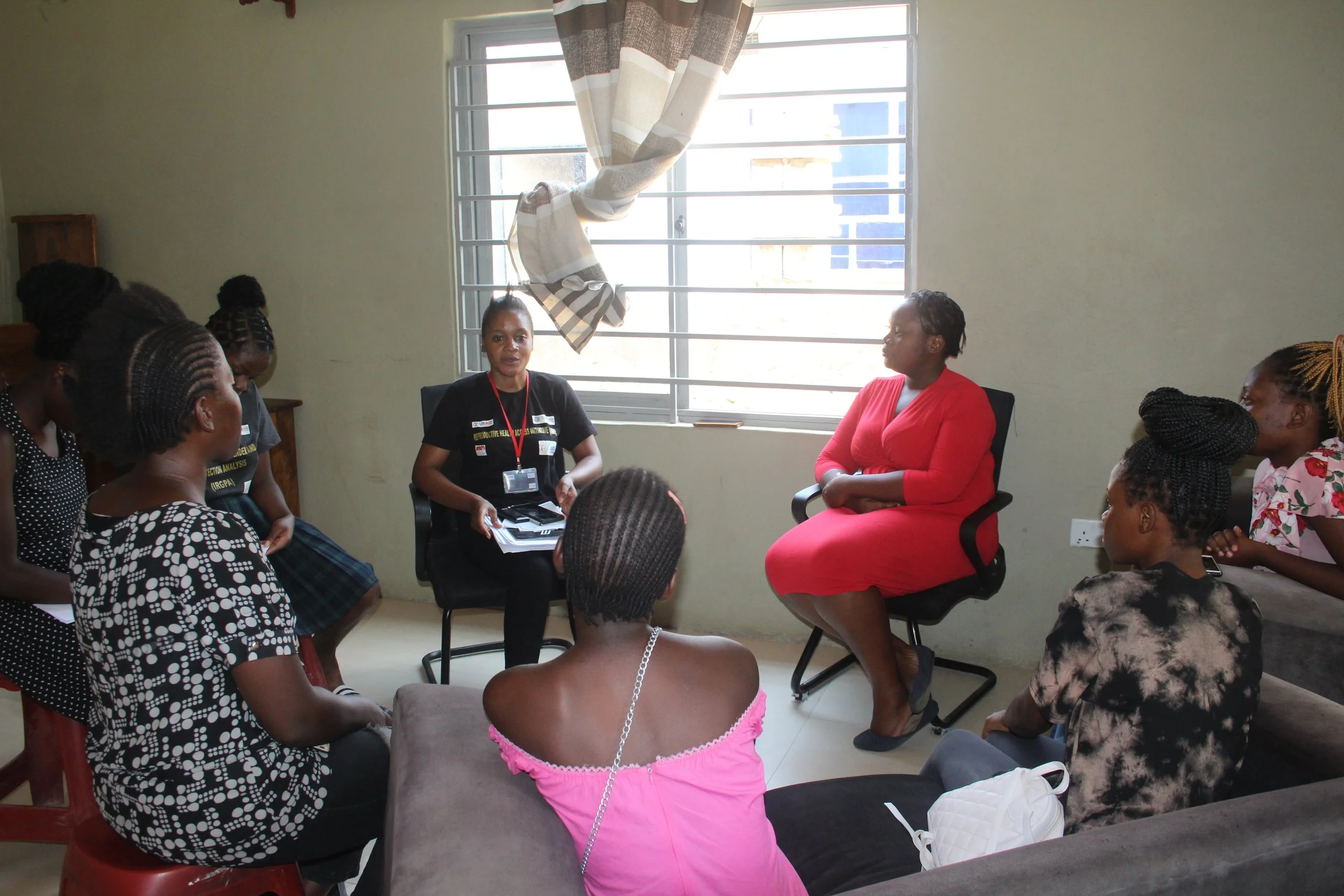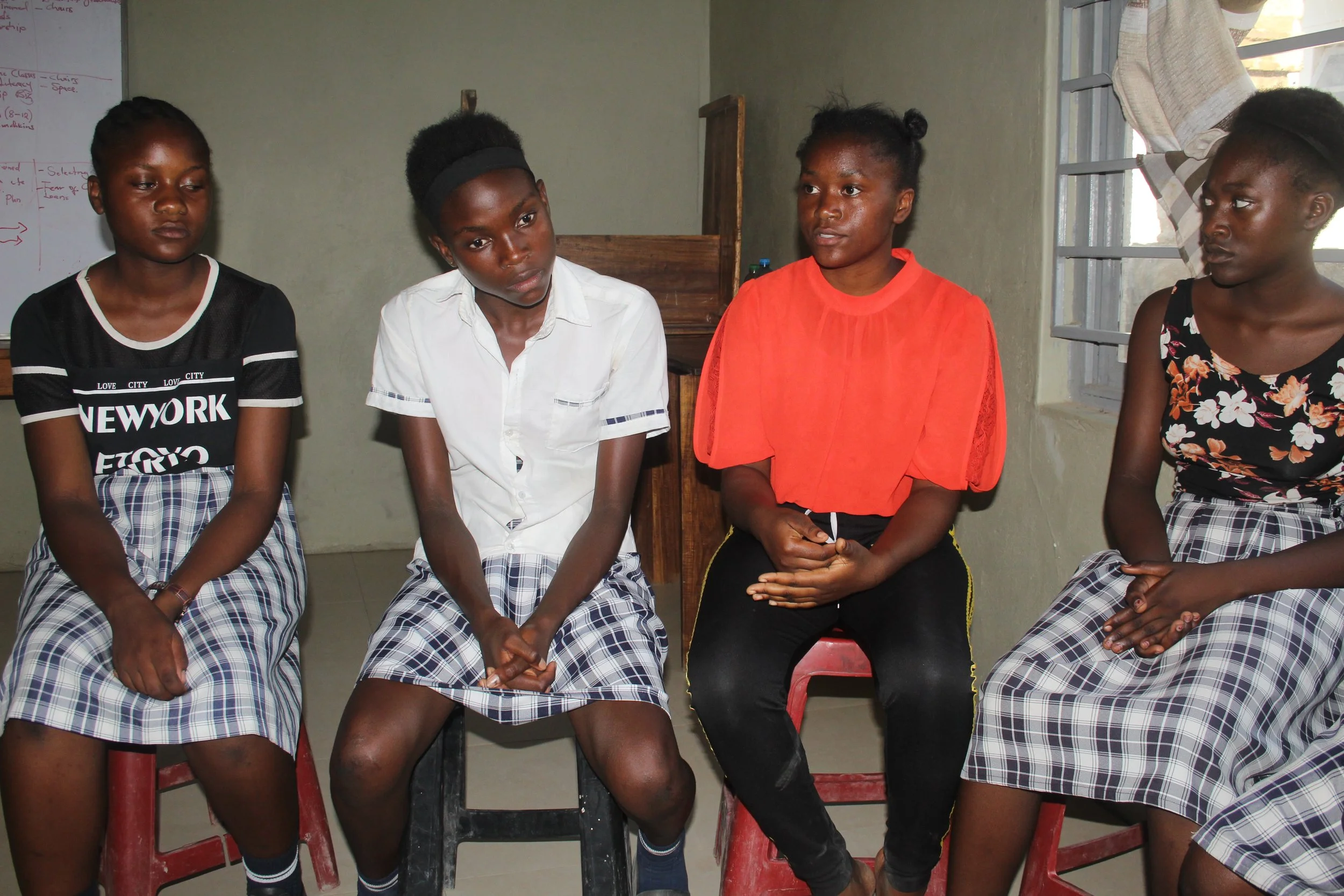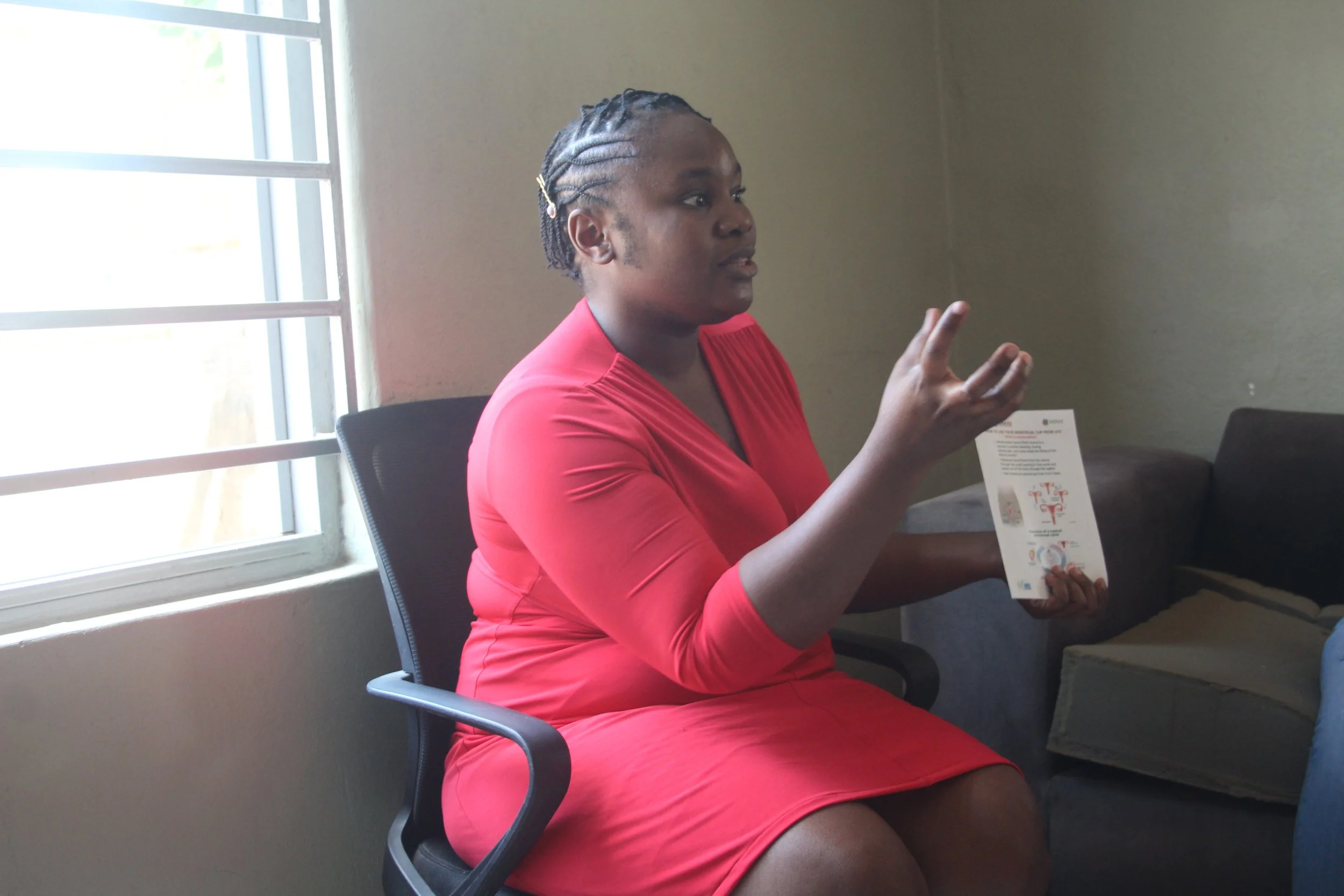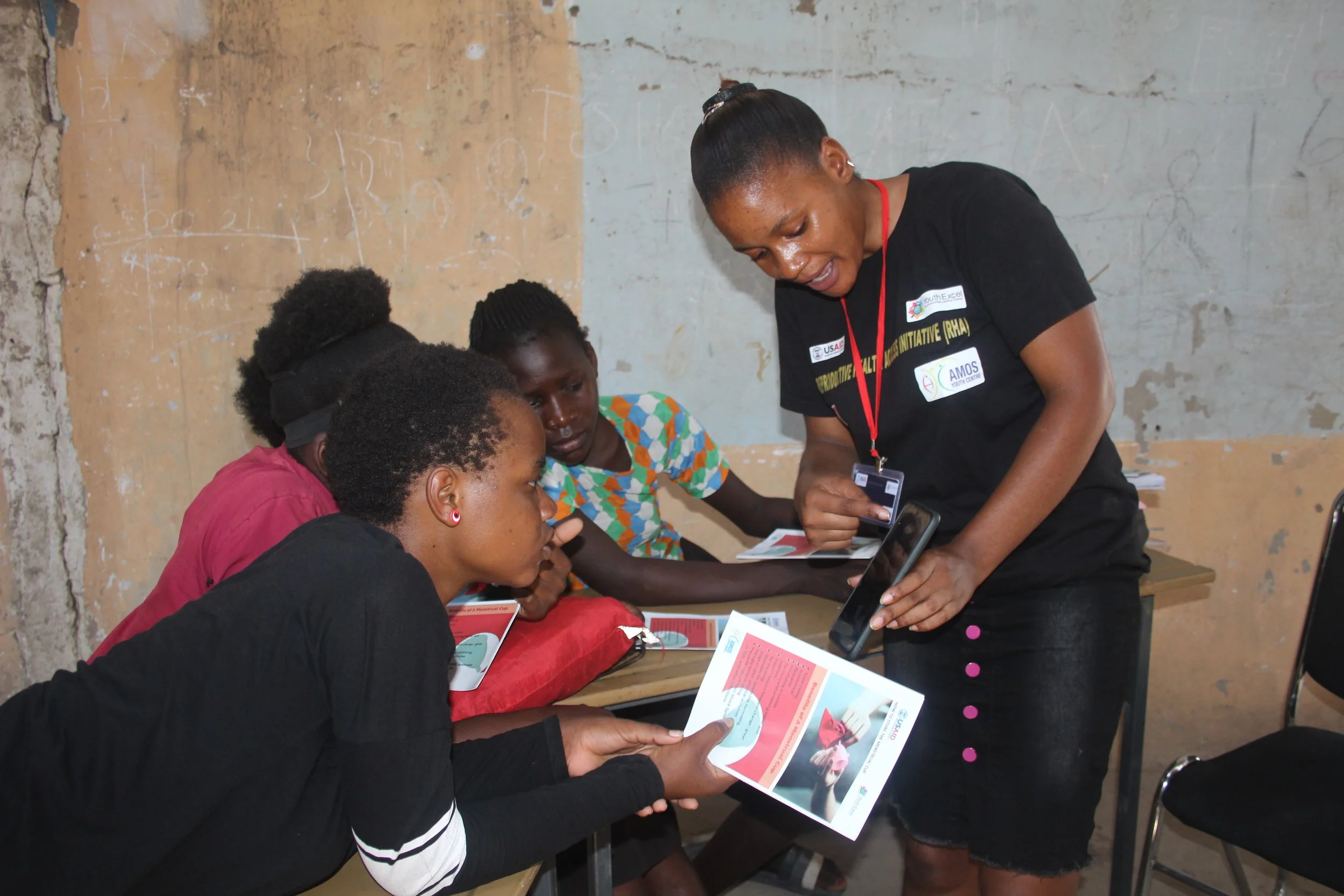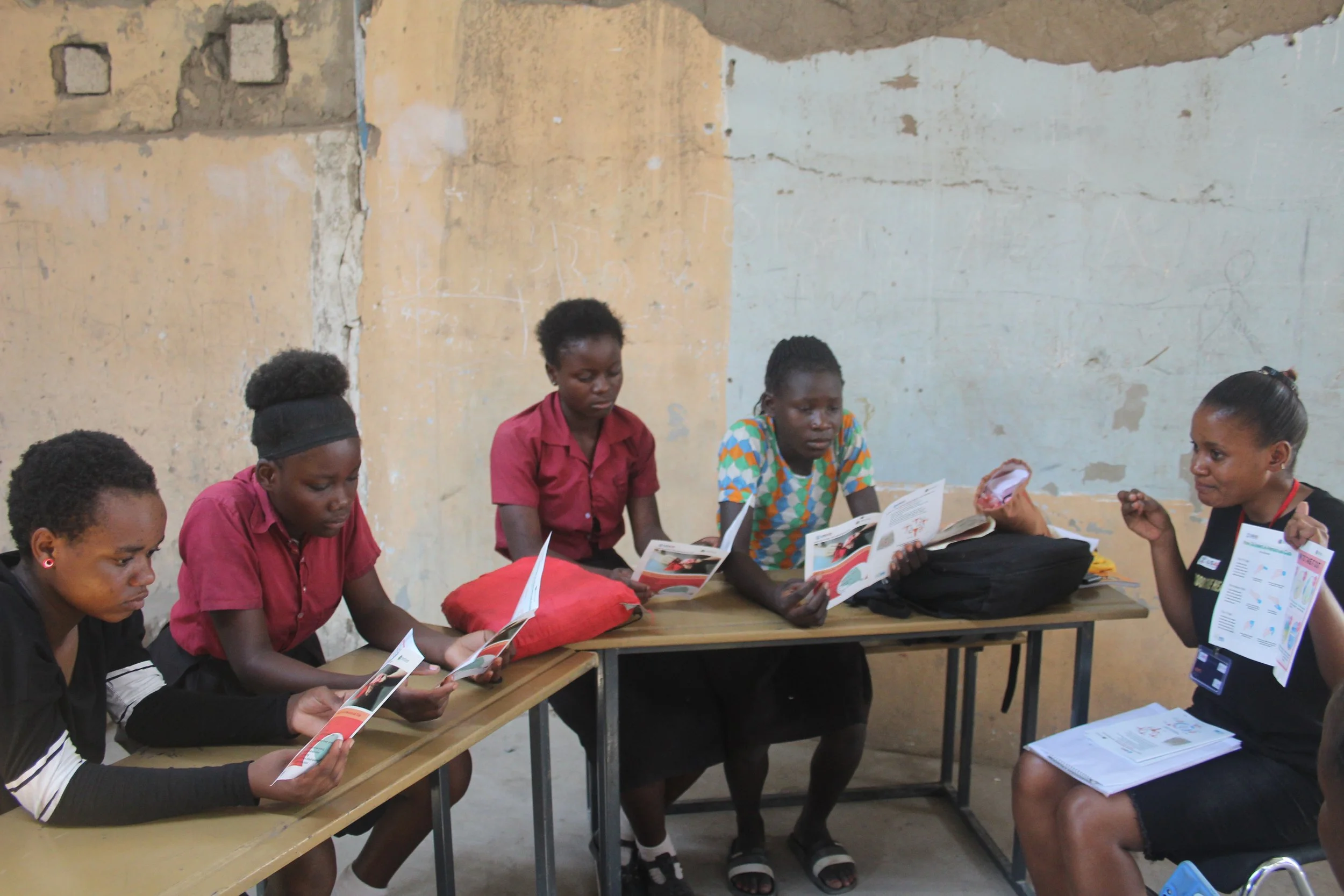USAID Youth Excel: A Research Project with Impact
By Annabel Mumba
Annabel Mumba is AYC’s Donor Relations Coordinator in Zambia. She is a Scholarship Fund recipient, high school graduate and current college student, and also one of our Success Stories.
Co-written by Pamela O’Brien, African Education Program’s Development Director, who is mentoring Annabel as she pursues a journalism degree.
The Amos Youth Centre was awarded a USAID Youth Excel Research-to-Change grant in July 2022 to strengthen menstrual health and hygiene (MHH) management for girls’ education in Zambia and Malawi. This activity provided small grants ($40,000–$50,000) to local, youth-led, and youth-serving organizations. In some cases, these were the first USAID grants that these organizations received, and this was the case for our organization as well. Out of 56 applicants, five winners from Zambia and Malawi, including Amos Youth Centre, were chosen to represent their respective MHH projects.
Youth Excel is a global program that empowers young people and youth organizations to use implementation research to strengthen local, national, and global development solutions. They provide tools and technical assistance to grantees so that they can conduct their own implementation research to strengthen their own programming priorities and ultimately embed research into their programming sustainably.
For the past four years, the Amos Youth Centre has been implementing the Reproductive Health Access Initiative (RHAI) which provides a safe and welcoming space for girls and young women aged 10 to 25, including our differently-abled girls in the Read for Rose Special Education Program, to receive menstruation products, training, and reproductive health information. The different menstruation products distributed include reusable menstrual pads, menstrual cups, and period underwear.
Now that the project has concluded, we look back to identify some of the elements that contributed to the success of this research project and share our experience conducting the research, as well as how we were able to share the findings and data collected with numerous local and global stakeholders.
What factors contributed to the success of this research project? What were the difficulties encountered, and how did the team overcome them? How did this research help the Amos Youth Centre communicate the story of this incredible program that is assisting many young people in our community? Also, what was the impact of the research?
Four interns, all high school graduates and alumni of Amos Youth Centre, were hired to conduct research for the Youth Excel grant.
Christine, AYC’s Program Assistant, interviewed girls for the research study.
Since 2009, the Amos Youth Centre has prioritized reproductive health for both girls and boys. Menstrual health and welfare remain an issue for many girls and young women in Zambia, since many still lack access to period products and information about this vital phase of their lives. Girls and young women in our programs are well-informed and have unrestricted access to reproductive health information and reusable menstrual hygiene supplies.
The study had a keen interest in investigating whether access to our RHAI improved educational results for girls in Kafue.
The first objective was to undertake an Intersectional Rapid Gender and Protection Analysis (IRGPA), a critical method for identifying the varying needs and capacities of women, men, boys, girls, and gender nonconforming people. The tool's significance is that it assists the research team to better understand the context in which they work, as well as the roles that gender, inclusion, and protection play in the implementation of Youth Excel activities and programs.
The interns who would be working on this project needed to be hired and trained before the research could begin. Modester, Richard, Gloria, and John, four high school graduates and alumni of our program, were chosen to conduct desk research on different populations and structures existing in Kafue. The team also conducted interviews with government and private institutions to collect information on statistics, needs/challenges in communities, different groups present in communities, protection points in the district, and the connectors of different groups in Kafue.
After three days of interactive IRGPA and protection training, they were ready to go. The interns' training included a session on trauma care and protection which was vital because they had to go through psychosocial counseling to prepare their minds for the research.
Interviews, focus groups, and surveys were among the methodologies employed by the researchers. In total, the team met with 152 girls and 102 parents. For the focus groups, it was important to collect research from small groups that included girls who attended Amos Youth Centre and participated in the RHAI and also girls in the community who did not attend our center or any RHAI sessions. One of the challenges the team had during data collection was actually tracking down all of their mothers to get their input.
The research team had very insightful discussions around menstrual health and hygiene and the traditions that still stand in the community.
1. 100% of the mothers whose girls did not have access to the RHAI reported that they did not know about the reusable menstrual cup and it was their first time seeing the cup.
2. Over 60% of the mothers reported they were not aware of the onset of periods (menarche) with their daughters. Traditionally, a girl is advised to tell a grandmother or aunt, who will later inform the mother about their "menstrual journey".
In addition, 20 school administrators were interviewed. The engagement of school administrators in the research was critical because they are responsible for implementing the research findings in the school.
School administrators also have the authority to advocate for measures that promote MHH in schools. When the girls are on their periods, they continue to miss school. This is due to a scarcity of menstrual health products at schools, a lack of appropriate washrooms, and effective methods of managing period pain.
School administrators were interviewed for the Youth Excel Research-to-Change project.
The girls who participated in this study acquired a lot of information about menstrual health and controlling period cramps, how to store and use the menstrual cup, how to calculate the timing of their periods, and how to manage emotions during periods. This information was also circulated in a brochure that they could take home.
Many focus group discussions took place during the research phase of the project.
LEARNING GOALS
The first learning goal was to find out whether providing menstrual cups, training, and education to mothers of girls who participated in the RHAI increases the uptake and use of menstrual cups among girls so that we may increase the number of mothers participating in the RHAI.
The second learning goal was to determine whether participation in RHAI contributes to improvements in girls’ attendance, school participation, and academic achievement so that we can adapt our programming to improve education outcomes for our participants.
Finding out whether RHAI participation helps girls attend school more frequently and perform better academically was another consideration so that we could modify our programming and improve the educational outcomes for our participants.
We interviewed a focus group of mothers who received the menstrual cup from one of our first distributions. These women also have children enrolled in the program, and their daughters have received MHH supplies such as reusable pads, a menstrual cup, and period underwear. Olia is the mother of a girl participating in the programs at Amos Youth Centre and the RHAI. She spoke about the research and the RHAI.
“I had some questions about the cup when my daughter first brought it to me, but after attending the training and receiving the cup to try it out myself, I was confident in the product and approved of it. The focus group discussion also introduced me to people who held similar values to mine; together with the same women, we learned a lot and shared a lot. ”
Since 2019, the Centre has distributed 502 reusable menstrual cups, 500 reusable menstrual pads, and 12 period underwear to differently-abled girls. The distribution has contributed to an increase in school attendance and participation in school activities.
Challenges
The road to this entire research project was not an easy one. The team did meet a few challenges, one of which was from the mothers, who felt that the menstrual cup contradicted their beliefs and cultural norms. To deal with this, the team learned early on to respect cultural views and not modify the community's current traditions.
“I think what kept this research going and a success was the immense support from both the AYC and the African Education Program (AEP) teams. AEP’s Director of Development, Pamela O’Brien, was very instrumental in AYC applying and being awarded the grant. Through the entire process, AEP provided technical support too. Additionally, the Youth Excel and IREX team were available to us and gave us a leading hand with every challenge we faced. This research not only represented the work of the team that conducted the research but also the overall work that has been achieved by the organization over the years. The data that we have collected will be very helpful as we continue to grow our menstrual health program in the community that we serve. We have also learned invaluable lessons that we may have overlooked, like the involvement of the mother when distributing menstrual products.”
According to the data gathered, mothers were not discussing menstruation, cleanliness, and health habits with their daughters since it is considered taboo. They would either teach their daughters to sort things out for themselves or leave it to their grandmothers and aunties.
Another challenge came from the research interns who were collecting data for the IRGPA in the field. Some offices were unwelcoming, and others refused to offer the necessary information. One of the researchers, Richard, spoke about his experience conducting the research.
“It was an exciting experience for me because it was my first time conducting research. It felt daunting to go into the workplace to do interviews. Overall, I gained endurance and patience. I was always reminded of the research training.”
Lumuno, CoFounder and Director of Programs at Amos Youth Centre, met representatives from USAID Zambia and Grassroots Soccer in Ghana.
Results of the Research
At the end of the research, the team now had to decide how it was going to share the findings and data collected to better promote menstrual health and hygiene (MHH). The first sharing sessions were with Youth Excel, IREX, USAID, and other peer organizations.
These sessions allowed for cross-learning and collaboration among the organizations, enabling them to collectively develop strategies and best practices for promoting menstrual health hygiene in both Malawi and Zambia. Additionally, the team explored opportunities to disseminate the findings through conferences, workshops, and online platforms to reach a wider audience and maximize the impact of their research.
The next step was to share the findings of the research with local stakeholders in the community. The AYC team held its first stakeholder meeting on September 5th. This meeting had attendance from ten local schools, five peer organizations, and six government departments and ministries.
At this stakeholder meeting, we were able to have great conversations around menstrual health and hygiene. Some of the attendees advised the project team that to fully incorporate new menstrual health and hygiene services, there is a need to respect tradition and culture and understand why these norms were created. By doing this, we will create a community where people will not feel attacked or misunderstood.
A Ministry of Health representative recommended parents have more open discussions about MHH and for fathers to take an active role in addressing menstruation and reproductive health with their children.
Everyone was interested to hear about the studies at this gathering and learn about the many menstrual products that have been offered to our girls on the program. A local school's guidance teacher expressed how much she would love to have the team come in and instruct the girls on these products and MHH at her school.
Lumuno Chongo, Amos Youth Centre’s Co-Founder and Director of Programs who managed the project, was also invited to attend a Youth Excel Youth Engagement Data Summit conducted by Youth Excel and USAID in Accra, Ghana, from the 11th to the 15th of September. Overall, the summit brought together USAID staff, youth champions, and allies, as well as young leaders and representatives of local youth-led organizations from across Africa and the world, to discuss how young leaders are engaging locally and globally, using data and digital tools to create positive change in communities and countries.
This summit provided an opportunity for the Amos Youth Centre to showcase its research findings and network with other organizations from across the world.
Over a hundred people heard Lumuno speak with pride about the organization's use of MHH to support girls in staying in school and increasing their participation in extracurricular activities.
“It was very exciting to meet people from around the world, through this, I was also able to meet people that I have only interacted with virtually; these were the different partners and Youth Excel staff who provided support during the project. It was an honor to share to so many people about our work and shine light on our work in the communities of Kafue.”
The research not only provided exposure, but it also taught the organization's program staff how to successfully implement programs.
“The research was very successful; all of the sleepless nights and long working hours paid off in the end. This project has taught me a lot of things that I know will benefit me in my profession. As a project implementer, this research has revealed issues that I was previously unaware of. I am also relieved that it has ended and look forward to conducting similar studies in the future.”
Teddy Sakala, AYC’s Monitoring and Evaluation Coordinator, was in charge of analyzing and interpreting the data once it was collected. He was happy to be a part of this research and see it through to completion. He credits the project's success to the teamwork and assistance he received from the Youth Excel staff.
“My overall takeaway from the entire research project was it is hard work and I have always been open to work. It was not easy but the end results are amazing. I would regularly meet virtually to seek assistance on how to read the data and interpret it and I think that helped it to be less difficult.”
Program Adaptations
The team also discovered that there is room for improvements and research in the distribution of more convenient menstrual hygiene products to persons with mobility impairment, i.e., menstrual cups may not be the right fit or user-friendly for all girls. After discovering this, the team distributed menstrual underwear to girls with disabilities, which was reported as a more user-friendly product compared to the menstrual cups. This adaptation will ensure that all girls have access to MHH products that are suitable for them to attend school and participate in activities.
Recommendations
Finally, the team was able to give recommendations on the RHAI to stakeholders and other organizations that wish to undertake the same research.
1. The first recommendation is that organizations implementing MHH activities should conduct engagement sessions with parents, guardians, and communities in MHH program design, implementation, and evaluation in order to understand social and cultural norms existing in communities.
2. The second recommendation is that organizations implementing MHH activities should conduct research on convenient, sustainable, and environmentally safe menstrual hygiene products that can be used by all people, including those with disabilities.
3. The third recommendation is that schools and educational governmental offices should incorporate more MHH programs into the school curriculum to further break all taboos and stereotypes around MHH.
4. The last recommendation is that schools and educational government offices ensure the availability of adequate washrooms for MHH management while at school.
It was quite surprising to learn that many of the girls who attend community schools do not have access to proper washrooms at the schools. In order to effectively manage their periods, these girls would go home and often not return to school.
Thanks to our Reproductive Health Access Initiative, and the entire team, the Amos Youth Centre is changing lives for the better!


